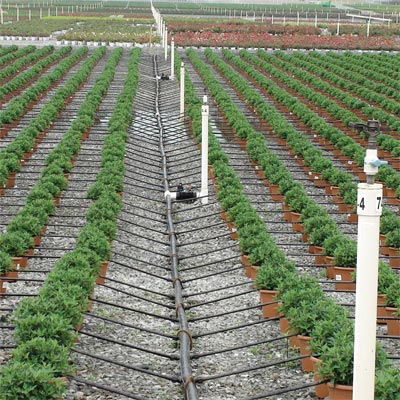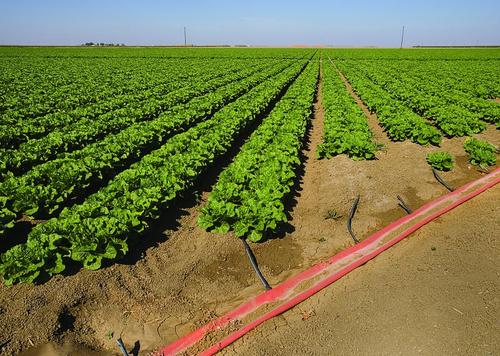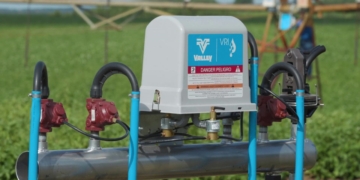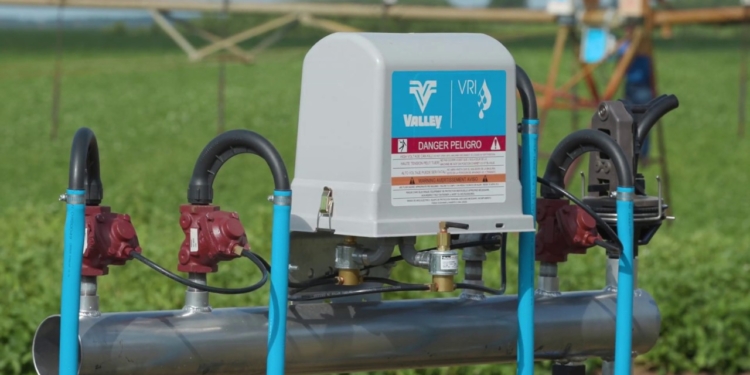Quite a few farmers and horticulturists are concerned about the availability of sufficient and high-quality irrigation water. Efficient use of the available water is also receiving increasing attention.
Together with various partners in the research field and the Province of West Flanders, Inagro has set up a great deal of research and advice on water and irrigation in agriculture and horticulture in recent years.
The rainfall of the past week means that all drought indicators are normal to (very) wet. Today, thinking about irrigation seems further than ever. But every farmer and horticulturist knows that weather conditions can change quickly.
The fairly wet spring makes you forget that since 2017 Flanders has been confronted with periods of prolonged drought and capping restrictions and pumping bans as a result. Nevertheless, it is expected that such a situation will become increasingly common in the future. Practice Center Inagro is already preparing for this. On June 22, it presented the findings and strategies around smart capture and irrigation techniques during a webinar for farmers and horticulturists.

Dominique Huits, soil, water and fertilization researcher at Inagro, and her colleagues closely follow the crisis consultations at Flemish level during drought periods. If the Flemish Drought Commission determines that it is becoming dry in a region, the governor concerned is requested to take appropriate measures, who will convene the provincial Drought Commission for this purpose.
This may concern, for example, a capping limitation. “But such a decision is not taken lightly,” says Huits. “The governor receives the necessary information for this from the committee, which includes representatives of all watercourse managers, the drinking water companies and the agricultural sector and nature organizations. Think of the precipitation and the predicted precipitation, the discharges in the watercourses, the groundwater levels of the shallow groundwater and the water quality.”
Assessment framework now supports governor in decision
In order to better support the decision of the governors, the Flemish government worked last year on an assessment framework that culminated in the drought plan . “Threshold values have been worked out for the various drought indicators and color codes are used,” explains Huits. “An underlying model has also been drawn up that objectively determines the mitigating effect of a certain measure on the water availability for nature. The assessment framework also takes into account the cost price of a measure.”
The assessment framework will be tested this summer. An evaluation will follow after the summer. “But let’s hope for a sensible summer with some good precipitation every now and then,” she concludes.
“The most important and independent effort on water supply can be made by the farms themselves“
Larger private water supply empowers farmers and horticulturists
At the end of 2019, water broker Dries Mergaert started working at Inagro to look for opportunities to make water available to the agricultural and horticultural sector in a sustainable way. Today, the search for suitable water sources is more urgent than ever. With a focus on the two major pillars of private water supply and communal, alternative water sources, the West Flemish water broker is working on a larger water supply for farmers and horticulturists in the province.

“The most important and independent effort can be made by the farms themselves,” says Mergaert. “They create an extra water supply via an open water well, foil basin or water silo. In addition, they can use different water sources, such as ground water, surface water and rainwater. We provide advice on the advantages and disadvantages of the different storage systems, the success factors and the steps that farmers and horticulturists need to take to expand their water supply.”
Alternative water sources
The WaterRadar application connects the water demand with the supply. ILVO, VITO, Vlakwa and Inagro are working together on this platform in the VLAIO Irrigation 2.0 project that will run until the autumn of 2022. “With this online tool, growers can easily look for alternative water sources near their plots”. explains Tim De Cuypere, precision agriculture researcher at Inagro.
In concrete terms, the focus is on both treated domestic wastewater from Aquafin installations and treated wastewater from food processing companies. In addition, the WaterRadar also visualizes theoretical irrigation needs on a regional scale, giving interested companies and local authorities additional insight into the theoretical irrigation needs in their region. This allows them to start up local projects that better match the supply and demand of water and facilitate sustainable and circular water use.
Testing with treated wastewater, drip irrigation and organic mulch
Research center Inagro is also expanding its practical knowledge about irrigation and the well-considered use of water through various tests. The results are an important source of information for independent and applied advice for growers in the various subsectors of agriculture and horticulture.
In order to map the long-term effects of irrigation with alternative water sources, Inagro has been conducting irrigation trials on fields with potatoes, cauliflower and spinach since 2019. “In addition to the availability of sufficient irrigation water, water quality is often a tricky issue,” explains De Cuypere. “In the irrigation trials, we irrigate the crops under controlled conditions with purified waste water. We are investigating what effect irrigating with alternative water sources has on crop yield and quality as well as on the soil.”
Inagro’s Biological Farming Test Company is conducting a trial on drip irrigation in cauliflower and fennel. “This technique is often referred to as a more economical irrigation method, in which the water is used exactly where it is needed,” says Joran Barbry, research leader in organic agriculture.
For the application in open air cultivation, challenges are often of a practical nature. Think of the combination with mechanical weed control or questions about the required material, possible problems during cultivation, the placement of the irrigation hoses and the reusability. “In our test, we compare aboveground and underground dripping hoses. The first tests showed the usefulness of drip hoses under dry conditions,” it sounds. In 2021 Inagro will continue the trial to also evaluate reusability.
In addition to irrigating, keeping naturally present soil moisture available for the main crop is also of great importance. “In the same project we compare different organic mulch materials in the cultivation of fennel. We applied grass clover, wood chips and compost in two different thicknesses to assess their impact on soil moisture and weed pressure,” said Barbry. In the first trial, all mulching materials were able to limit soil moisture loss through evaporation and significantly reduce weed pressure. In order to compare a wider range of organic mulch materials, Inagro will also add straw, mushroom compost (mushroom fertilizer) and compost chips to the trial in 2021.
App helps growers to control irrigation strategy
It is very useful if growers can easily call up advice themselves, without the intervention of an advisor. The MIRLET app was created to help greenhouse horticulturists control their irrigation strategy. “MIRLET is a handy advice tool to support growers of leafy crops in soil cultivation in their irrigation management,” says Simon Craeye, researcher greenhouse vegetables and strawberries at Inagro.
Since 2016, MIRLET has been used successfully in all seasons and on various Flemish soils, both in head lettuce and in alternative lettuce varieties. A solar-powered sensor module registers the necessary climate data in the crop. In the MIRLET app, growers can see how much moisture has evaporated daily and therefore ideally needs to be replenished. Determining the optimal time of irrigation and carrying out irrigation effectively remain important tasks for the grower.
“Many growers use the app to test their trusted irrigation strategy against reality. That gives them instructive insights,” concludes Simon. Interested growers can still contact the relevant trial centers.
More information at www.inagro.be .

































